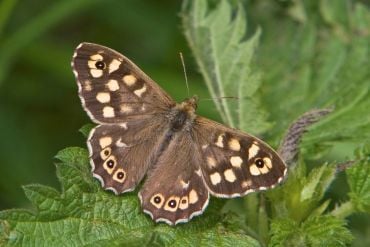University of Oxford researchers have led a new study which found that hedgerows, small copses and even individual trees can significantly increase the number of butterflies in farmed landscapes. The findings have been published today in the journal Ecological Solutions and Evidence .
The study, carried out by the University of Oxford and national charity Butterfly Conservation, funded by The Woodland Trust, comes at a critical time for butterfly species. Recent data revealed that 2024 was one of the worst years for butterfly numbers across the UK , with more than half of species in long-term decline for the first time on record. In the new study, the researchers found that having more hedgerows and trees in the landscape increased numbers of butterflies found in the countryside such as Speckled Wood, Gatekeeper, Meadow Brown, Ringlet and Comma. Hedgerows, small woodlands and trees were especially important for butterflies in more arable landscapes.
 Dr Ruth Feber.
Dr Ruth Feber.The researchers are now calling for farmers and landowners to get better support to maintain such valuable natural assets on their land.
Lead author Dr Ruth Feber ( Department of Biology , University of Oxford) said: 'We know that butterflies are in desperate trouble, including our common countryside species. Butterflies are important indicators of wider biodiversity, so actions that help butterflies will also help other declining wildlife. With 70% of the UK's land area being farmland, our farmers and landowners play a vital role in helping these species recover, through protecting and restoring hedgerows and trees.'
As part of the study, the researchers also surveyed 31 farmers and found that, while many saw trees and hedgerows on their land as having a range of benefits, they also raised concerns about the costs and commitment needed to maintain them.
Dr Feber added: 'It is clear that farmers recognise the importance of these crucial habitats, but they need to be supported: we need to recognise that these trees and hedgerows provide public goods which benefit wildlife and people.'
The team analysed a decade of survey data from 1154 1km squares across England surveys carried out by volunteers across England as part of the Wider Countryside Butterfly Survey (WCBS) run by Butterfly Conservation and the UK Centre for Ecology and Hydrology. This involves volunteers walking a one-kilometre route and counting the number of butterflies they see of each species.
Butterflies are important indicators of wider biodiversity, so actions that help butterflies will also help other declining wildlife. With 70% of the UK's land area being farmland, our farmers and landowners need to be supported in their vital role helping these species recover, through protecting and restoring hedgerows and trees.
Dr Ruth Feber , Department of Biology, University of Oxford
The researchers then cross-referenced these results with the habitats in a three-kilometre radius around each route and found that hedgerows and small woodlands had a positive impact on butterflies, especially in more arable landscapes. The more of these habitats there were, the more Meadow Brown, Gatekeeper, Speckled Wood, Ringlet and Comma were spotted. Areas of ancient woodland were positively associated with Speckled Wood and Ringlet.
'As well as demonstrating the importance of trees and hedgerows for biodiversity on farmland, our results also highlighted the relatively lower numbers of butterflies on intensively managed grassland compared to arable land,' said Dr Feber. 'With improved grassland covering over a quarter of the UK's land area, there is enormous potential for biodiversity benefits if its management can be targeted to enhance biodiversity.'
The study forms part of the Department of Biology's Wildlife Conservation Research Unit (WildCRU)'s wider research programme on farming and wildlife. Its overarching aim is to advance understanding of how agriculture and wildlife interact and provide an evidence base to help tackle the pressing challenges facing farmers, conservationists and policy makers. Within this work, Dr Feber focuses on the responses of biodiversity, and the ecological processes underlying them, to land management interventions and land use change at different spatial scales and across taxonomic groups.
 Speckled Wood butterfly.
Credit: Keith Warmington.
Speckled Wood butterfly.
Credit: Keith Warmington.'My current project is investigating regenerative farming, which uses livestock grazing and other practices to help promote soil health and increase soil carbon,' said Dr Feber. 'This is receiving increasing attention as an approach to grassland management that might contribute to tackling some climate impacts of agriculture but more research is needed on how this may impact biodiversity, particularly above-ground invertebrate groups, such as butterflies, moths and other pollinators.'
To help fill these evidence gaps, Dr Feber is working at the University of Oxford's Northfield Farm, managed by the Food Animal Initiative (FAI), which uses a "mob" grazing approach. 'In this system, areas of land are grazed for a short period of time before the cattle are moved on and the pasture allowed to recover,' she said. 'I am using butterflies as a model group to study whether this grazing system, together with field margin and hedgerow management, offers opportunities to enhance habitat quality and landscape connectivity for biodiversity. Ultimately these findings could provide valuable insight into how policy incentives should be structured to support farmers undertaking management actions that deliver biodiversity benefits.'
The study 'Quantifying the value of trees outside woods for promoting biodiversity on farmland' has been published in Ecological Solutions and Evidence .






